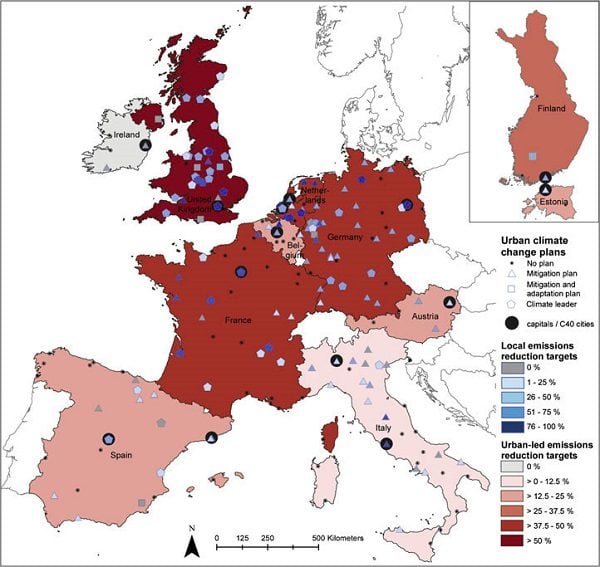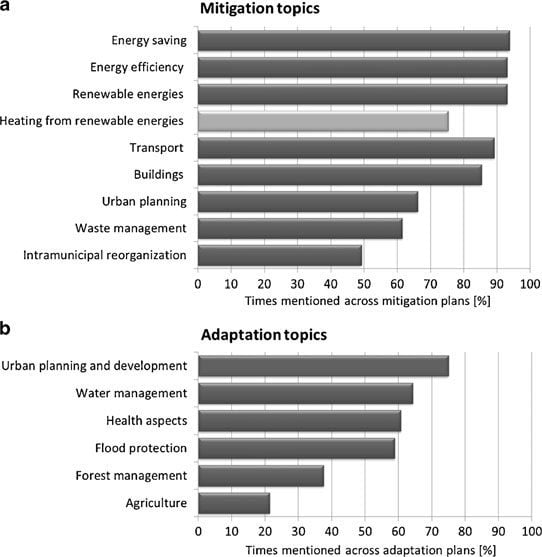

Economy
Just one in four European cities fully prepared for climate change
Seven out of 10 European cities have no formal plans to adapt to climate change, and one in three have no plans to reduce greenhouse gas emissions, writes David Thorpe.
This article originally appeared on Sustainable Cities Collective.
The shocking news comes from research by Diana Reckien of Columbia University in the US and 11 European colleagues, published in the journal Climatic Change. It involved questionnaires followed up by interviews and an investigation to find out exactly what cities are doing to protect themselves or curb emissions. It does not just rely on published policies.
The team analysed 200 large (over 250,000 population) and medium-sized (about 50,000) urban areas in 11 European countries and ranked the countries accordingly.
 The headline results are:
The headline results are:
– Overall, 130 cities (65%) have at least a mitigation plan, but less than a third (28%) also an adaptation plan
– More than one in every three cities (35%) has no plan whatsoever in place
– Only one in every four cities (25%) had both, and also set quantitative targets to reduce greenhouse gas emissions
– Most (88%) mitigation plans quantify targets for carbon dioxide or greenhouse gas emission reduction
– 93% of UK cities studied have a mitigation plan
– Only 43% of French and 42% of Belgian cities do
– The highest proportion of cities with an adaptation plan are in the UK (80% of 30 cities), Finland (50% of four cities) and Germany (but just 33% of 40 cities)
– Dutch cities are the most ambitious aiming to be carbon, climate or energy neutral (100% reduction target) by 2050 or earlier
Many British cities have signed up to the Nottingham Declaration on Climate Change, begun over 10 years ago, and its successor, the Climate Local Commitment. This has the support of the Department for Communities and Local Government (DCLG), the Department for Environment, Food and Rural Affairs (Defra), the Department for Energy and Climate Change (DECC) and the Environment Agency. This activity itself arises from Local Agenda 21 initiatives which followed from the 1992 Rio Earth Summit, so it goes back over 20 years.
In France, legislation requires all major cities to have a climate change mitigation and adaptation plans in place over a year ago, but out of 35 cities, 14 have still failed to do so.
The researchers state that if the European Union were to be represented by these cities, then it would certainly achieve its declared target of a 20% reduction in emissions, but this would be way short of the 80% reduction needed to keep global average warming below the maximum level of 2C.
“Not all cities with high ambitions lie in countries with a national target as seen in the Netherlands. Likewise, an ambitious national target is no guarantee of an ambitious urban target. Every country analysed that has a nationally agreed target has cities without a [greenhouse gas] emission reduction target”, the researchers say.
Reckien’s team was funded by the European Science Foundation COST Action TU0902. They scrutinised adaptation plans which incorporate urban planning and development actions that lead to the abatement or reduction of vulnerability to climate change, and mitigation plans that include actions such as improved energy efficiency and renewable energy generation to reduce greenhouse gas emissions.
The report says, “The highest proportions of cities with an adaptation plan are in the UK (80% of 30 cities), Finland (50% of four) and Germany (33% of 40 cities). In 22% of all cities studied, the mitigation and adaptation actions are integrated into a joint strategy (predominantly in the UK, Finland, and France), which increases the likelihood of integration and consideration of possible trade-offs and feedbacks between adaptation and mitigation policies.”
The European Union is an important contributor to global warming, releasing approximately 11% of global carbon emissions, and has established some of the most ambitious supra-national targets and policies. It has provided leadership which many of its cities have followed, some more than rising to the challenge set by legislation and seeing it as a terrific opportunity for improving the quality of life for their citizens.
However, the study reveals that many other cities have yet to take action and realise the benefits for themselves.
“To better understand the global climate change response and emissions reduction actions, we recommend the establishment of an international database of mitigation and adaptation options that builds upon this European study”, writes Reckien.
She makes the remark partly because the researchers find a wide variation in climate change response across this representative sample of urban areas in Europe — a variation that is particularly noticeable across city size and north-south direction. The magnitude of urban greenhouse gas reduction targets varies considerably, ranging from 7% to 100%.
Cities account for between 31% and 80% of greenhouse gas emissions globally and contain more than half of the world’s population.

Mitigation and adaptation topics in climate change plans. The figure shows the most frequently named topics in all of the mitigation (a) and adaptation (b) plans. Lighter grey represents a subcategory.

A carbon tree for the 111 urban areas with mitigation targets. Each city is denoted by a horizontal bar, or branch. Urban areas from the same country have the same colour. The vertical position of the branch refers to the magnitude of the emission reduction target in per cent, indicated by the scale on the right. The black boxes on the scale denote all those cities that fall into the exact increment of 10% that the box surrounds, i.e. there are seven cities that have a reduction target of exactly 30%, all encompassed by the upper and lower limit of the box that surrounds the number 30.
David Thorpe is community manager of Sustainable Cities Collective. He’s also a novelist, script and comics writer, environmental writer, journalist, and editor. He was for 13 years news editor of Energy & Environmental Management magazine, and is director of Cyberium, a media company.
Further reading:
Existing city infrastructure can be ‘reprogrammed’
Our future cities will have to be smarter and more resilient
Report: green spaces ‘central’ to successful cities
£250,000 prize for city blueprint that mixes nature with architectural splendour
Mayors pledge to fight climate change as cities ‘are on the frontlines’


 Environment10 months ago
Environment10 months agoAre Polymer Banknotes: an Eco-Friendly Trend or a Groundswell?

 Environment12 months ago
Environment12 months agoEco-Friendly Home Improvements: Top 7 Upgrades for 2025

 Features9 months ago
Features9 months agoEco-Friendly Cryptocurrencies: Sustainable Investment Choices

 Features10 months ago
Features10 months agoEco-Friendly Crypto Traders Must Find the Right Exchange




























